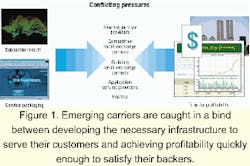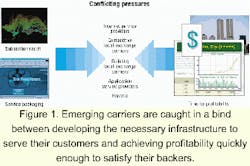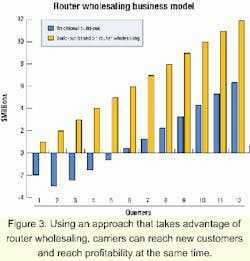Rethinking routers: the service of router wholesaling
Just like dial wholesaling, wholesale routing can open new revenue streams and streamline facility build-outs.
DAVID GINSBURG, Allegro Networks
Routing as a service, not a product, is what's needed for facilities-based carriers constantly on the lookout for ways to generate additional revenue and margin from their physical network infrastructures. With more than 50 backbone providers in the United States alone, competing on least-cost bandwidth is not a path to survival and no longer rewarded by the financial community. Unfortunately, monolithic router architectures are fundamentally no different than what they were at the end of the 1980s, with the exception of greater speeds and denser feeds.
Some large carriers derive revenue from hosting and from broadband access, but these services are subject to increasing commoditization. Looking back historically, the last disruptive technology shift that changed the fundamental business relationship between the carrier and Internet service provider (ISP) was dial wholesaling. Rethinking routing as a service rather than a product has the potential to create a similar, new, disruptive broadband business model. Only then will the industry evolve from its current downward spiral of nonprofitability.
In the T-carrier-and-above space, facilities-based service providers spend billions of dollars every year laying fiber, purchasing capital equipment, and buying or leasing facilities. But many providers are seeing profits wane, as the majority of the newfound backbone network capacity lays idle.
Meanwhile, smaller, customer-facing service providers risk financial suicide, if they build their own network infrastructures in an attempt to attract high-revenue customers that require national or even global network coverage. This "build it and they will come" approach has proven disastrous for many smaller service providers. These providers initially intended to differentiate themselves based on customer-focused services rather than on the reach of their network footprint, but are now under financial pressure to demonstrate near-term profitability (see Figure 1).Similarly, for an ISP, traditional barriers to entering new markets have been rooted in capital outlay and human resources. These issues have distracted service providers from their initial business plans, many of which showed great promise for attracting and retaining customers focused in a specific niche.
A wireless ISP's intellectual capital, for example, lies in the receivers on radio towers in the cities where it offers service. The best way for a wireless ISP to gain more customers is to invest in more presence on the radio towers-that's why venture capitalists and Wall Street invested in them. Building a point-of-presence (PoP) infrastructure in every city and a backbone to tie those cities together is both inefficient and distracting to the ISP's core competency: wireless service.
The scenario is the same for today's service providers. Researching or building facilities in new markets can run into the millions of dollars. And even after the build-out is operational, it takes many more months for the local-exchange carrier to build capacity from its central office to the new facility. Add the backhauling process to the timeline, and the target customer has typically already chosen an alternative.
Collocation facilities now allow these providers to deploy equipment inside a guarded facility, which obviates the need to buy or build a new facility. However, collocation centers charge high rents, often cutting into service providers' margins. Outsourcing onsite operations can solve the manpower problem when the service provider centrally manages the network. But to contract with a top-notch support group that can offer the expected 4-hour onsite equipment replacement also is an expensive proposition.
Regardless of whether the ISP rents collocation space or buys a building, it must still contend with the costs of purchasing equipment, procuring operations support, and hiring a sales force.
The current climate for broadband access is similar to the dial-up access business before the introduction of the remote-access concentrator, which enabled dial wholesaling services. In the early 1980s, offering dial-up consumer access in a new city meant finding a facility, purchasing modems, then selling that access product to customers. The inefficiency of this approach was likened to the Campbell's Soup Co. opening up a manufacturing plant and a sales office in every city where they wanted to sell chicken soup-it just wouldn't provide economic scale.
After wholesale-enabled remote-access concentrators emerged in the mid-'80s, consumer-level service providers were able to enter new markets by leasing modems that were physically located inside a specially designed concentrator. The wholesaling service provider was able to host multiple service providers collocated inside a single chassis, achieving maximum revenue per dial-up access concentrator.
A symbiotic relationship emerged, establishing the dial-up ISPs as the sales and marketing force for the wholesaling service provider. Likewise, the dial-up ISPs entered new markets without building infrastructure, resulting in a much higher return on investment.
Dial wholesaling was predicated on a new class of platform that offered the necessary partitioning, scalability, and control to allow ISPs to exist autonomously in a carrier-owned platform. The ISP had to have confidence in its ability to maintain control over its subscribers, both in terms of connectivity as well as quality of service. Meanwhile, the carrier required a platform that could easily integrate into its existing operations, while offering the required scalability to grow its business.
Most importantly, these platforms had to be deployed and the service offered at a per-port charge that was acceptable to ISPs. Over time, this wholesaling model has proved quite profitable and in fact is one of the higher-margin services that carriers offer today. Technology has evolved to the point where we can extend this model to broadband, but as with dial, it requires a new, disruptive type of platform that rethinks the role of the router.
Today, when an ISP enters a new metropolitan area with the intention of providing broadband service, it must either lease or purchase a physical site for its PoP or collocate it within a shared data center. Each option has its downside. Purchasing or leasing a site for exclusive use involves a tremendous capital-expense outlay for the building itself, in addition to the required investment in edge routers, redundant peering routers, intra-PoP switching, and transmission.
Collocation can ease the expense of investing in real estate but brings a new set of issues to contend with from the standpoint of control and autonomy within the collocation facility. Whether the facility is controlled by the service provider or the equipment is collocated, regulatory issues and market lead times for equipment combine to create more headaches for those looking to physically build-out their networks.There is also an initial expense for the link connecting the PoP with the ISP's transit provider or backbone. The meter immediately starts ticking, so to speak, even if the ISP hasn't signed up a single subscriber in the new location. As the initial investment of hiring employees and purchasing capital equipment combines with growing operational expenses, the ISP's time-to-profitability fades into the future (see Figure 2).
The ISP must extend its reach to continue to attract customers. In all but the consumer DSL space, that entails a physical build-out with its associated capital expenses, long lead times, and complex peering arrangements. When the service provider expends its efforts on physical build-out, it has little time to differentiate, thus making it difficult to develop new and original services and ultimately making it impossible to increase the service provider's value proposition.
ISPs must therefore rethink how they enter new markets to offer broadband services. They must have at their disposal a service much like dial wholesaling, where they partner with a facilities-based provider for geographic expansion. This service is known as router wholesaling. If the service is to be attractive to both facilities-based carriers and customer-facing service providers, it must mirror their existing networking paradigms, be scalable, and be deployable at an acceptable cost.
ISP requirements mirror those of the facilities-based carrier. For the service provider to buy into a wholesale routing platform, it must perform like a traditional standalone router. At the end of the day, the ISP may have a network composed of a combination of traditional routers in some locations and leased routers on a wholesale platform in other locations. Configuration and troubleshooting of both must be identical, or any gains made through technology advancement could be lost in a nightmare of logistics and service issues.
Further requirements for autonomy and security will raise those table stakes even higher, requiring even more from the wholesale routing platform. The facilities-based carrier must be able to guarantee total autonomy for each ISP that leases space in its router. In no way can one service provider affect the performance of another.
Guarantees must also include perfect partitioning of management, so that the carrier cannot view the service provider's configuration files without explicit authorization. The final set of guarantees relate to reliability. The carrier must be able to offer the ISP specific service-level agreements (SLAs) for its leased router, permitting the service provider to guarantee SLAs to its business customer.
The cost of deployment is also an issue. As with dial wholesaling, if the cost of offering the service in terms of capital and operational expenses is too great, the service will not be attractive to the ISPs. Any wholesale routing platform must therefore strike a required balance between functionality and cost.
Using current router technology, facilities-based carriers could deploy a wholesale routing service of sorts by operating standalone routers on behalf of the ISPs. In some cases, this scenario already exists. But the expense is prohibitive for the vast majority of service providers, as the magnitude of equipment involved precludes any thought of mainstream adoption. Scalability and manageability become a nightmare.Some vendors tout virtual routing as the "fix-all" for future scalability and expansion. But separate routing tables-be they Multiprotocol Label Switching or IPSec-enabled-still rely on a single route processor and centralized memory. That rules out any chance of partitioning by the service provider attempting to wholesale router services.
Thus, a new multirouter hardware platform is required for this physical autonomy, with an operating system that includes the architecture for the router wholesaling application.
Figure 3 contrasts the new service-provider business model based on router wholesaling with traditional infrastructure deployments. In a traditional deployment, the ISP requires an up-front capital investment to enter a new market. The time-to-profitability is therefore a function of how quickly the service provider is able to attract new customers to balance this initial expense along with ongoing operational expenses. Meanwhile, technology windows of opportunity are very short, and in the time a typical service takes to become profitable, it often has been bypassed by new technology.
In contrast, a router wholesaling solution allows the ISP to generate immediate profits, since its expenses are directly proportional to its customer base. Router wholesaling results in a winning proposition for both the facilities-based carriers as well as the value-added providers. Carriers benefit by being able to offer additional high-margin services, better utilizing their infrastructure, while value-added providers are no longer bound by the cost and time usually associated with physical infrastructure build-out to extend their reach. Profitability for both types of providers is enhanced, a critical factor if success is to be assured in the current environment.
Of course, an ISP operates more than just a router or a Web switch within a collocation facility. But just as the service provider has turned over dial and DSL to the wholesaler, the servers-and finally the routers-are next on the list, as wholesalers evolve their service offerings.
Rethinking routing as a service rather than a product will effectively reshape the typical broadband-access business model, resulting in enhanced profitability for ISPs due to lower expenses and quicker time-to-revenue recognition. Router wholesaling is just one example of this new way of looking at routing.
David Ginsburg is vice president of market ing at Allegro Networks (San Jose, CA). He is chair of the Broadband Content Delivery Forum (www.bcdforum.org).



